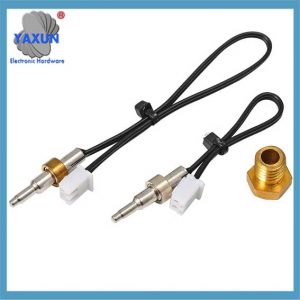In modern industrial and automotive electronic systems, sensor temperature sensing harnesses are widely used in temperature monitoring, fault diagnosis and safety systems as a key sensing technology. 센서 프로브 및 온도 측정 케이블 키트의 핵심 기술에는 온도 감지가 포함됩니다., 신호 전송 및 데이터 처리. 온도 수집 전문가 YAXUN은 센서 온도 감지 장치에 고정밀 Shibaura NTC 서미스터를 사용합니다., 감지 물질 포함, 신호 처리 기술, 통합 디자인과 향후 개발 동향.
1. Sensing materials
The core of the temperature sensing harness lies in its sensing materials. Currently, commonly used temperature sensing materials include Shibaura thermistors (NTC/PTC), thermocouples and fiber optic sensors.
Shibaura thermistors (NTC/PTC): The resistance value of NTC (음의 온도 계수) thermistors decreases as the temperature increases. The opposite is true for PTC (양의 온도 계수) 서미스터. By measuring the change in resistance, temperature information can be accurately obtained. These materials have high sensitivity and a wide temperature measurement range, but their application is limited by environmental conditions and resistance stability.
열전대: It is composed of two different metal wires and generates a voltage signal through the thermoelectric effect. Thermocouples have a wide temperature range and high stability, but their signal processing is complex and requires precise calibration and compensation.
Fiber optic sensor: Fiber-optic temperature sensing technology detects temperature by monitoring changes in light. This sensor has high sensitivity and anti-interference ability, and is suitable for temperature monitoring in harsh environments.
2. Signal processing technology
The signal processing technology of the sensor temperature sensing harness includes two parts: analog signal conversion and digital signal processing.
Analog signal conversion: The signal output by the sensor is usually an analog signal, which needs to be converted into a digital signal through an analog-to-digital converter (ADC). During the analog signal conversion process, issues such as noise suppression, signal amplification and filtering need to be considered to ensure the accuracy and stability of the signal.
Digital signal processing: Digital signal processing technology can further analyze and process the digital signal output by the sensor. 예를 들어, algorithms are used for temperature compensation, error correction and data smoothing. Modern temperature sensing harnesses often integrate microprocessors or microcontrollers to implement complex signal processing and data analysis functions through software.
3. Integrated design
The integrated design of temperature sensing harnesses involves comprehensive consideration of sensors, signal processing units, and connecting harnesses.
Sensor integration: Embedding the sensor module into the harness can achieve space savings and compact system design. The layout of the sensor needs to consider the accuracy and response speed of temperature measurement, while ensuring the mechanical strength and durability of the harness.
Signal transmission: In terms of signal transmission, it is necessary to select appropriate wires and connectors to reduce signal attenuation and interference. High-quality shielding and insulation materials can improve the stability of signal transmission.
System integration: Modern temperature sensing harnesses often need to be integrated with other electronic systems, including communication interfaces, data storage, and processing units. System integration design needs to consider compatibility, 신뢰할 수 있음, and scalability to meet the needs of different application scenarios.
4. Future development trends
With the advancement of science and technology, the technology of temperature sensing harnesses is also developing. Future trends include:
Intelligence: Temperature sensing harnesses will gradually develop towards intelligence, and realize self-diagnosis, adaptive adjustment, and remote monitoring functions by integrating more sensors and processing units.
소형화: With the miniaturization of electronic components, the size of temperature sensing harnesses will become smaller and smaller, suitable for more compact and complex application scenarios.
높은 신뢰성: Future temperature sensing harnesses will pay more attention to reliability and durability to meet the application requirements in harsh environments, such as high temperature, high humidity and strong vibration environments.
Multifunctionality: In addition to the traditional temperature measurement function, future temperature sensing harnesses may integrate more functions. 예를 들어, humidity detection, pressure measurement, 등., to provide more comprehensive environmental monitoring capabilities.
5. 결론
As an important sensing technology, the core technologies of Shibaura NTC thermistor temperature sensing harness include sensing materials, signal processing technology and integrated design. 과학과 기술의 발달로, temperature sensing harnesses will develop in the direction of intelligence, miniaturization and multifunctionality to meet more complex application requirements. Through continuous technological innovation, temperature sensing harnesses will play an increasingly important role in industry, automotive electronics and other fields.
Functional characteristics
Shibaura thermistor element:
Due to the use of glass encapsulation, compared with resin encapsulated thermistors, it has excellent heat and weather resistance and longer service life.
Since the lead wire is bonded to the thermistor chip via a gold electrode, the characteristics are stable (PSB-S, NS, PL type thermistor elements).
특징
Structure with metal welding electrodes
Excellent tinning due to tin-plated metal electrodes
Excellent heat resistance and weather resistance due to glass encapsulation
Excellent solder heat resistance during assembly
Since square glass is used, there will be no poor fixings such as displacement and falling off during actual assembly
Application examples
Suitable for the following temperature measurement applications corresponding to SMT (surface mount);
Applications requiring higher reliability than general-purpose chip thermistors;
Overheat prevention for industrial motors;
Temperature compensation for IGBT (insulated gate bipolar transistor) devices;
Temperature compensation for general electronic parts of SMT (surface mount);
Operating temperature range -50~+200℃;
Thermal time constant Approximately 10 초;
Dissipation constant Approximately 1.4W/℃;
Solder heat resistance 350℃ 3 초;
※Unless otherwise specified, thermal time constant and dissipation constant are test results in still air.
 English
English العربية
العربية Български
Български 粤语
粤语 中文(简体)
中文(简体) 中文(漢字)
中文(漢字) Nederlands
Nederlands Suomi
Suomi Français
Français Deutsch
Deutsch Ελληνικά
Ελληνικά Magyar
Magyar Italiano
Italiano 日本語
日本語 한국어
한국어 Polski
Polski Português
Português Română
Română Русский
Русский Slovenščina
Slovenščina Español
Español Svenska
Svenska ภาษาไทย
ภาษาไทย Türkçe
Türkçe Tiếng Việt
Tiếng Việt



